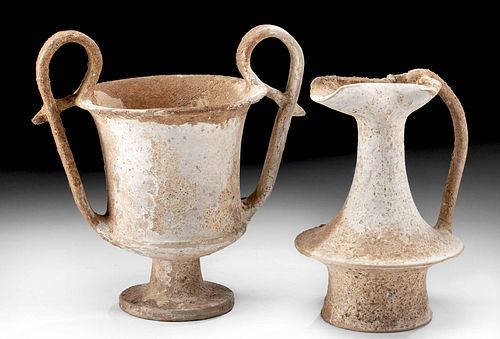Greek Canosan Pottery Kantharos + Epichysis
Lot 23b
About Seller
Artemis Fine Arts
686 S Taylor Ave, Ste 106
Louisville, CO 80027
United States
Selling antiquities, ancient and ethnographic art online since 1993, Artemis Gallery specializes in Classical Antiquities (Egyptian, Greek, Roman, Near Eastern), Asian, Pre-Columbian, African / Tribal / Oceanographic art. Our extensive inventory includes pottery, stone, metal, wood, glass and textil...Read more
Categories
Estimate:
$2,200 - $3,300
Absentee vs Live bid
Two ways to bid:
- Leave a max absentee bid and the platform will bid on your behalf up to your maximum bid during the live auction.
- Bid live during the auction and your bids will be submitted real-time to the auctioneer.
Bid Increments
| Price | Bid Increment |
|---|---|
| $0 | $25 |
| $300 | $50 |
| $1,000 | $100 |
| $2,000 | $250 |
| $5,000 | $500 |
| $10,000 | $1,000 |
| $20,000 | $2,500 |
| $50,000 | $5,000 |
| $100,000 | $10,000 |
| $200,000 | $20,000 |
About Auction
By Artemis Fine Arts
Oct 8, 2020
Set Reminder
2020-10-08 10:00:00
2020-10-08 10:00:00
America/New_York
Bidsquare
Bidsquare : Exceptional Antiquities, Asian, Ethnographic
https://www.bidsquare.com/auctions/artemis-gallery/exceptional-antiquities-asian-ethnographic-5796
Museum-worthy examples of Egyptian, Greek, Roman, Etruscan, Near Eastern, Far East / Asian, Pre-Columbian, African / Tribal,Oceanic, Native American, Spanish Colonial, Russian, Fossils, Ancient Jewelry, Fine Art, so much more! Artemis Fine Arts info@artemisfinearts.com
Museum-worthy examples of Egyptian, Greek, Roman, Etruscan, Near Eastern, Far East / Asian, Pre-Columbian, African / Tribal,Oceanic, Native American, Spanish Colonial, Russian, Fossils, Ancient Jewelry, Fine Art, so much more! Artemis Fine Arts info@artemisfinearts.com
- Lot Description
Magna Graecia, Southern Italy, Greek colony of Apulia, Canosa, ca. 4th century B.C.E. An excitingly rare find! Two elegant wheel-thrown pottery vessels in hues of creamy white, pink, and blue over the buff clay body from the Apulian region of Italy. The kantharos (wine cup) rests upon a circular base with a short narrow foot, a deep cylindrical body, and a flared rim. Twin handles climb gracefully from the rimmed base of the body and flourish above the sides in loops before meeting the rim and piercing through their interiors. The epichysis (wine pitcher) possesses a characteristically spool-shaped base with a corseted body and sloped shoulder leading to a thin cylindrical neck and a pinched spout joined to the shoulder by a delicate arched handle. These attractive vessels were once ordained in a style unique to Canosa, which included added water-solvent pink and blue pigment over a chalky white background, some of which may still be seen. Two exceptional examples from ancient Apulian life to bring to your next symposium! Size of Largest: 5.375" Diameter x 6" H (13.7 cm x 15.2 cm)
The kantharos form can be traced as far back as the 8th century BCE, and in later times kantharoi feature prominently on black- and red-figure vases, often carried by Dionysus or Herakles. Canosa was a major center of the ceramics and pottery trade when it was a Greek polis. It produced truly unique pottery, completely different in decoration style (although not in shape) from earlier and neighboring traditions. The clay is buff, with the decoration applied directly to it without the use of slip.
Provenance: private New York, New York, USA collection, ex-collection of the Swiss archaeologist Professor Dr. med. Ernst Berger (1928 - 2006)
All items legal to buy/sell under U.S. Statute covering cultural patrimony Code 2600, CHAPTER 14, and are guaranteed to be as described or your money back.
A Certificate of Authenticity will accompany all winning bids.
We ship worldwide and handle all shipping in-house for your convenience.
#159293Both have white collection labels on their bases, naming their previous gallery and acquisition number. The epichysis has a repair on base, one minor chip on corseted rim of shoulder, and two small chips on spout. Both have surface wear commensurate with age. Lovely encrustations and remarkable amount of remaining white pigment. Intact and excellent.Condition
- Shipping Info
-
All shipping is handled in-house for your convenience. Your invoice from Artemis Gallery will include shipping calculation instructions. If in doubt, please inquire BEFORE bidding for estimated shipping costs for individual items.
-
- Buyer's Premium



 EUR
EUR CAD
CAD AUD
AUD GBP
GBP MXN
MXN HKD
HKD CNY
CNY MYR
MYR SEK
SEK SGD
SGD CHF
CHF THB
THB
















